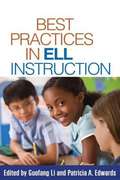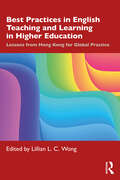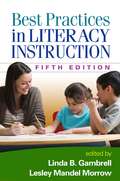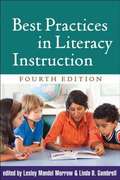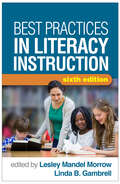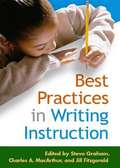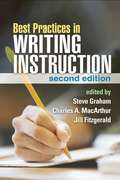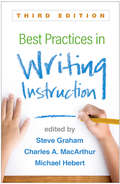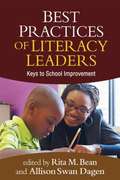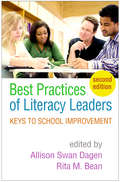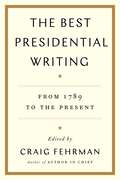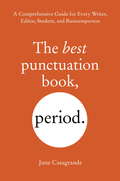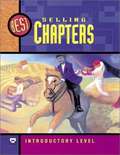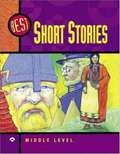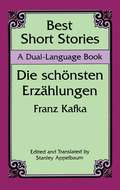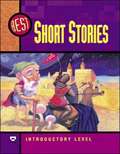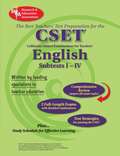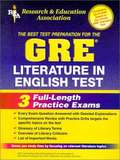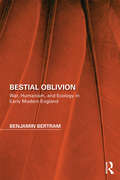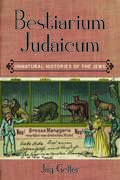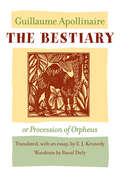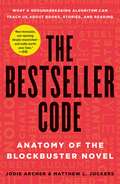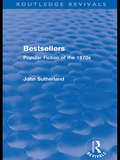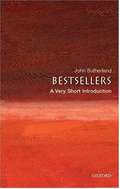- Table View
- List View
Best Practices in ELL Instruction
by Guofang Li Patricia EdwardsIn this indispensable work, prominent authorities review the latest research on all aspects of ELL instruction (K 12) and identify what works for today's students and schools. Provided are best-practice guidelines for targeting reading, writing, oral language, vocabulary, content-domain literacies, and other core skill areas; assessing culturally and linguistically diverse students; and building strong school home community partnerships. Chapters include clear-cut recommendations for teaching adolescent ELLs and those with learning disabilities. The comprehensive scope, explicit linkages from research to practice, and guidance for becoming a culturally informed, reflective practitioner make the book an ideal course text.
Best Practices in English Teaching and Learning in Higher Education: Lessons from Hong Kong for Global Practice
by Wong, Lillian L. CLillian Wong brings together evidence- informed studies which are at the forefront of higher education developments in English language teaching and learning, and shares expertise from prominent academics in Hong Kong. Written by experienced practitioners who are active in the evolving field of scholarship of teaching and learning, it provides accessible and engaging insights into best practices in new and innovative areas, such as communities of practice, scholarship, big data analytics, digital literacies, blended learning, small private online courses, dialogic use of exemplars, students as tutors and critical thinking. The book covers best practices in three interrelated key areas in university English language education, including curriculum design and pedagogy, use of technologies and the teaching and learning of English in the disciplines. Linking theory and practice, the chapters discuss the emphasis on EAP/ ESP in university English language education, how technological developments are impacting the field and the implications for further research and the teaching of English in higher education. This resourceful collection is essential reading for teachers in- service and intraining, or those working in language education at the tertiary level where English is being used as an academic lingua franca, a medium of instruction or where EAP/ ESP plays an important role. Researchers in TESOL and applied linguistics, curriculum designers and leaders, teacher educators and policymakers as well as undergraduate and postgraduate students will also find it valuable.
Best Practices in Literacy Instruction
by Ernest Morrell Heather Kenyon Casey Lesley Mandel MorrowThis authoritative text and PreK–12 teacher resource is now in a substantially revised seventh edition with 80% new material, foregrounding advances in inclusive, equitable instruction. Teachers are guided through every major component of reading, as well as assessment, motivation, teaching bilingual learners, strengthening connections with families and communities, and more. The book presents principles and strategies for teaching literature and nonfiction texts, organizing and differentiating instruction, supporting struggling readers, and promoting digital literacy. Pedagogical features include chapter-opening bulleted previews of key points; reviews of the research evidence; recommendations for best practices in action, with examples from exemplary classrooms; and end-of-chapter engagement activities.
Best Practices in Literacy Instruction, Fifth Edition
by Timothy Shanahan Linda B. Gambrell Lesley Mandel MorrowThis indispensable classroom resource and course text has inspired thousands of teachers to help their students become better readers and writers. The fifth edition addresses evidence-based best practices in the light of emerging research and national policy, actively tying classroom-based research, innovation, and instruction to the Common Core State Standards (CCSS). Practical suggestions and case studies empower PreK-8 teachers to support the needs of all their students while meeting Common Core goals. Each chapter includes concrete examples, Engagement Activities, and resources for further learning. New to This Edition: *Connects best practices with the requirements of the CCSS. *Incorporates the latest research findings and instructional practices. *Chapters on comprehending informational text, dual language learners, and new literacies. *Expanded topics include motivation, close reading, and text complexity.
Best Practices in Literacy Instruction, Fourth Edition
by Linda Gambrell Lesley MorrowA highly regarded teacher resource and widely adopted text, this book is grounded in current knowledge about literacy teaching and learning in grades Perk 8. The field's leading authorities present accessible recommendations for best practices that can be tailored to fit specific classroom circumstances and student populations. Provided are strategies for helping all students succeed including struggling readers and English language learners and for teaching each of the major components of literacy. The book also addresses ways to organize instruction and innovative uses of technology. Chapters include concrete examples, Engagement Activities, and resources for further learning. New to This Edition Incorporates the latest research findings and instructional practices. Chapters on motivation, content-area teaching, new literacies, and family literacy. Addresses timely topics such as response to intervention, the new common core standards, English language learning, and policy issues.
Best Practices in Literacy Instruction, Sixth Edition
by Lesley Mandel Morrow Linda B. Gambrell Heather Kenyon CaseyMany tens of thousands of preservice and inservice teachers have relied on this highly regarded text from leading experts, now in a revised and updated sixth edition. The latest knowledge about literacy teaching and learning is distilled into flexible strategies for helping all PreK–12 learners succeed. The book addresses major components of literacy, the needs of specific populations, motivation, assessment, approaches to organizing instruction, and more. Each chapter features bulleted previews of key points; reviews of the research evidence; recommendations for best practices in action, including examples from exemplary classrooms; and engagement activities that help teachers apply the knowledge and strategies they have learned. New to This Edition *Incorporates the latest research findings and instructional practices. *Chapters on new topics: developmental word study and the physiological, emotional, and behavioral foundations of literacy learning. *Chapters offering fresh, expanded perspectives on writing and vocabulary. *Increased attention to timely issues: classroom learning communities, teaching English learners, and the use of digital tools and multimodal texts.
Best Practices in Writing Instruction
by Steve Graham Charles MacarthurHighly practical and accessible, this indispensable book provides clear-cut strategies for improving K-12 writing instruction. The contributors are leading authorities who demonstrate proven ways to teach different aspects of writing, with chapters on planning, revision, sentence construction, handwriting, spelling, and motivation. The use of the Internet in instruction is addressed, and exemplary approaches to teaching English-language learners and students with special needs are discussed. The book also offers best-practice guidelines for designing an effective writing program. Focusing on everyday applications of current scientific research, the book features many illustrative case examples and vignettes.
Best Practices in Writing Instruction, Second Edition
by Steve Graham Charles A. Macarthur Jill FitzgeraldAn indispensable teacher resource and course text, this book presents evidence-based practices for helping all K-12 students develop their skills as writers. Every chapter draws clear connections to the Common Core State Standards (CCSS). Leading authorities describe how to teach the skills and strategies that students need to plan, draft, evaluate, and revise multiple types of texts. Also addressed are ways for teachers to integrate technology into the writing program, use assessment to inform instruction, teach writing in the content areas, and tailor instruction for English language learners and struggling writers. Helpful case examples are featured throughout.New to This Edition*Revised and expanded to address the CCSS.*Incorporates the latest research and instructional procedures.*Chapters on teaching argumentative and informative writing.*Chapters on college and career readiness, writing to learn, writing about texts, and response to intervention.
Best Practices in Writing Instruction, Third Edition
by Steve Graham Charles A. MacArthur Michael HebertWell established as a definitive text--and now revised and updated with eight new chapters--this book translates cutting-edge research into effective guidelines for teaching writing in grades K–12. Illustrated with vivid classroom examples, the book identifies the components of a complete, high-quality writing program. Leading experts provide strategies for teaching narrative and argumentative writing; using digital tools; helping students improve specific skills, from handwriting and spelling to sentence construction; teaching evaluation and revision; connecting reading and writing instruction; teaching vulnerable populations; using assessment to inform instruction; and more. New to This Edition *Chapters on new topics: setting up the writing classroom and writing from informational source material. *New chapters on core topics: narrative writing, handwriting and spelling, planning, assessment, special-needs learners, and English learners. *Increased attention to reading–writing connections and using digital tools. *Incorporates the latest research and instructional procedures. See also Handbook of Writing Research, Second Edition, edited by Charles A. MacArthur, Steve Graham, and Jill Fitzgerald, which provides a comprehensive overview of writing research that informs good practice.
Best Practices of Literacy Leaders
by Rita. M BeanBringing together leading experts, this book presents the principles of effective literacy leadership and describes proven methods for improving instruction, assessment, and schoolwide professional development. The book shows how all school staff including reading specialists and coaches, administrators, teachers, and special educators--can play an active role in nurturing a culture of collaboration and promoting student achievement. Best practices are identified for creating strong elementary and secondary literacy programs, differentiating instruction, supporting English language learners, utilizing technology, building home-school partnerships, and much more. User-friendly features include case examples, guiding questions, and engagement activities in each chapter.
Best Practices of Literacy Leaders, Second Edition: Keys to School Improvement
by Allison Swan Dagen Rita M. BeanThis authoritative text and practitioner resource has now been extensively revised and expanded with 70% new material covering new topics and standards in literacy leadership. Prominent experts present research-based methods for improving instruction, assessment, and professional learning experiences in PreK–12. The distinct roles of teachers, reading/literacy specialists, literacy coaches, special educators, and principals are explored, with an emphasis on fostering a culture of collaboration. Chapters highlight the standards that apply to each component of a schoolwide literacy program, give examples of what they look like in schools, and share implications for classroom practice and professional learning. Pedagogical features include guiding questions, case examples, vignettes, engagement activities, and annotated resources for further learning. New to This Edition *Now copublished with the International Literacy Association (ILA) and grounded in ILA's revised Standards 2017; expanded grade range includes PreK. *Chapters on new topics: writing instruction, sustaining schoolwide improvements, and collaborative leadership. *New chapters on core topics: the principal&’s role, assessment, middle and high school literacy programs, special education, and culturally responsive instruction. *Vignettes from leaders in diverse roles, &“Think About This&” questions for discussion/reflection, and end-of-chapter annotated resources.
The Best Presidential Writing: From 1789 to the Present
by Craig FehrmanA sweeping, groundbreaking, and comprehensive treasury of the most essential presidential writings, featuring a richly varied mix of the beloved and the little-known, from stirring speeches and shrewd remarks to behind-the-scenes drafts and unpublished autobiographies.From the early years of our nation&’s history, when George Washington wrote his humble yet powerful Farewell Address, to our current age, when Barack Obama delivered his moving speech on the fiftieth anniversary of the Selma-to-Montgomery marches, America&’s presidents have upheld a tradition of exceptional writing. Now, for the first time, the greatest presidential writings in history are united in one monumental treasury: the very best campaign orations, early autobiographies, presidential speeches, postpresidential reflections, and much more. In these pages, we see not only the words that shaped our nation, like Abraham Lincoln&’s Emancipation Proclamation and Franklin D. Roosevelt&’s Infamy speech, but also the words of young politicians claiming their place in our history, including excerpts from Woodrow Wilson&’s Congressional Government and Obama&’s career-making convention speech, and the words of mature leaders reflecting on their legacies, including John Adam&’s autobiography and Harry S. Truman&’s Memoirs. We even see hidden sides of the presidents that the public rarely glimpses: noted outdoorsman Teddy Roosevelt&’s great passion for literature or sunny Ronald Reagan&’s piercing childhood memories of escorting home his alcoholic father. Encompassing notable favorites like Lincoln&’s Gettysburg Address and John F. Kennedy&’s Inaugural Address as well as lesser-known texts like Thomas Jefferson&’s Notes on the State of Virginia and James Polk&’s candid White House diary, The Best Presidential Writing showcases America&’s presidents as thinkers, citizens, and leaders. More than simply a curation of must-read presidential writings, this unique collection presents the story of America itself, told by its highest leaders. What is America? Who is America for? What will America become? Since our nation&’s founding, different presidents have offered different answers. In their writings, we see frontiers expand, ideals transform, and novel ideas take root. Even the most famous speeches find new meanings or fresh connections when read in this sweeping context, making The Best Presidential Writing a trove full of insight and an essential historical document.
The Best Punctuation Book, Period: A Comprehensive Guide for Every Writer, Editor, Student, and Businessperson
by June CasagrandeThis all-in-one reference is a quick and easy way for book, magazine, online, academic, and business writers to look up sticky punctuation questions for all styles including AP (Associated Press), MLA (Modern Language Association), APA (American Psychological Association), and Chicago Manual of Style.Punctuate with Confidence--No Matter the Style Confused about punctuation? There's a reason. Everywhere you turn, publications seem to follow different rules on everything from possessive apostrophes to hyphens to serial commas. Then there are all the gray areas of punctuation--situations the rule books gloss over or never mention at all. At last, help has arrived. This complete reference guide from grammar columnist June Casagrande covers the basic rules of punctuation plus the finer points not addressed anywhere else, offering clear answers to perplexing questions about semicolons, quotation marks, periods, apostrophes, and more. Better yet, this is the only guide that uses handy icons to show how punctuation rules differ for book, news, academic, and science styles--so you can boldly switch between essays, online newsletters, reports, fiction, and magazine and news articles.This handbook also features rulings from an expert "Punctuation Panel" so you can see how working pros approach sticky situations. And the second half of the book features an alphabetical master list of commonly punctuated terms worth its weight in gold, combining rulings from the major style guides and showing exactly where they differ. With The Best Punctuation Book, Period, you'll be able to handle any punctuation predicament in a flash--and with aplomb.From the Trade Paperback edition.
Best-Selling Chapters: Introductory Level
by Steve StrausChapters from 8 Books for Young People with Lessons for Teaching the Basic Elements of Literature.
Best Short Stories: 10 Stories for Young Adults with Lessons for Teaching the Basic Elements of Literature (Middle Level)
by Raymond Harris McGraw-Hill - Jamestown Education StaffBanish boredom! Excite students with variety--drama, verse, stories, reporting, and more--all at comfortable reading levels. Five genres, each in three levels, let students study a particular kind of writing at the appropriate reading level Emphasis on reading skills helps students who have difficulty with a traditional literature anthology Integration of reading and writing encourages students to study how authors construct their works and then to try to emulate stylistic elements Rescue bored readers by introducing them to the many exciting forms of literature. The Best series collects superb nonfiction, play scripts, poetry,short stories, and stand-alone chapters of longer works, so you can quickly find well-crafted selections that reflect student interests. Best of all, we've tailored the series to three reading levels, making it the perfect tool for reaching out to students of any ability who aren't succeeding with more traditional anthologies. Introductory: Reading Level 5-6, Interest Level 6-8 Middle: Reading Level 7-8, Interest Level 6-10 Advanced: Reading Level 9-12, Interest Level 9-12
Best Short Stories: A Dual-Language Book (Dover Dual Language German)
by Franz KafkaStudents of German language and literature will welcome this dual-language edition of five stories by Franz Kafka (1883-1924). Considered one of the greatest modern writers, Kafka wrote tales that brilliantly explore the anxiety, futility, and complexity of modern life.The stories in this volume are "The Metamorphosis" (thought by many critics to be Kafka's most perfect work), "The Judgment," "In the Penal Colony," "A Country Doctor," and "A Report to an Academy." Along with the original German texts, Stanley Applebaum has provided accurate English translations on facing pages, affording students an ideal opportunity to read some of Kafka's finest stories in the original, to discover the passion and profundity of this extremely important figure in modern European literature, and to upgrade their German language skills.
Best Short Stories: Introductory Level
by Patricia Opaskar Mary Ann TrostThe Best Series is a fresh and innovative way to introduce and study genre-specific literature in your classroom. Students can explore and gain appreciation for exceptional and diverse writings in nonfiction, poetry, plays, short stories, and selections from novels. This enriching series strengthens students' reading and writing skills and literary techniques.
The Best Teachers' Test Preparation for the California CSET: English Subtests I-IV
by David M. Rosen Jean O. CharneyREA's new test preparation guide will help teacher candidates succeed on the California CSET in the subject area of English Subtests I through IV, which are: Subtest I: Literature and Textual Analysis; Composition and Rhetoric. Subtest II: Language, Linguistics, and Literacy. Subtest III: Composition and Rhetoric; Literature and Textual Analysis. Subtest IV: Communications: Speech, Media, and Creative Performance. Included are a self-assessment review and 2 practice tests of the competencies and skills required on California's official exam. Complete with detailed explanations to all answers, an adaptable study schedule, and test-taking drills and strategies that can improve your performance.
The Best Test Prep for the GRE Literature in English Test (2nd edition)
by James S. Malek Thomas C. Kennedy Bernadette Brick Pauline Beard Robert LiftigIncludes three full-length exams with detailed explanations modeled after the actual GRE in Literature in English. Presents questions based on various works of English and American literature of all periods. Also includes a comprehensive review, glossary of literary terms, overview of literary criticism, and a suggested reading list.
Bestial Oblivion: War, Humanism, and Ecology in Early Modern England (Perspectives on the Non-Human in Literature and Culture)
by Benjamin BertramAlthough war is a heterogeneous assemblage of the human and nonhuman, it nevertheless builds the illusion of human autonomy and singularity. Focusing on war and ecology, a neglected topic in early modern ecocriticism, Bestial Oblivion: War, Humanism, and Ecology in Early Modern England shows how warfare unsettles ideas of the human, yet ultimately contributes to, and is then perpetuated by, anthropocentrism. Bertram’s study of early modern warfare’s impact on human-animal and human-technology relationships draws upon posthumanist theory, animal studies, and the new materialisms, focusing on responses to the Anglo-Spanish War, the Italian Wars, the Wars of Religion, the colonization of Ireland, and Jacobean “peace.” The monograph examines a wide range of texts—essays, drama, military treatises, paintings, poetry, engravings, war reports, travel narratives—and authors—Erasmus, Machiavelli, Digges, Shakespeare, Marlowe, Coryate, Bacon—to show how an intricate web of perpetual war altered the perception of the physical environment as well as the ideologies and practices establishing what it meant to be human.
Bestiarium Judaicum: Unnatural Histories of the Jews
by Jay GellerGiven the vast inventory of verbal and visual images of nonhuman animals—pigs, dogs, vermin, rodents, apes disseminated for millennia to debase, dehumanize, and justify the persecution of Jews, Bestiarium Judaicum asks: What is at play when Jewish-identified writers tell animal stories? Focusing on the nonhuman-animal constructions of primarily Germanophone authors, including Sigmund Freud, Heinrich Heine, Franz Kafka, and Gertrud Kolmar, Jay Geller expands his earlier examinations (On Freud’s Jewish Body: Mitigating Circumcisions and The Other Jewish Question: Identifying the Jew and Making Sense of Modernity) of how such writers drew upon representations of Jewish corporeality in order to work through their particular situations in Gentile modernity. From Heine’s ironic lizards to Kafka’s Red Peter and Siodmak’s Wolf Man, Bestiarium Judaicum brings together Jewish cultural studies and critical animal studies to ferret out these writers’ engagement with the bestial answers upon which the Jewish and animal questions converged and by which varieties of the species "Jew" were identified.
The Bestiary, or Procession of Orpheus
by Guillaume ApollinaireFirst Place, Large Not-for-Profit Publisher, Typographic Text, 2011 Washington Book Publishers Design and Effectiveness AwardsGuillaume Apollinaire’s first book of poems has charmed readers with its brief celebrations of animals, birds, fish, insects, and the mythical poet Orpheus since it was first published in 1911. Though Apollinaire would go on to longer and more ambitious work, his Bestiary reveals key elements of his later poetry, among them surprising images, wit, formal mastery, and wry irony. X. J. Kennedy’s fresh translation follows Apollinaire in casting the poems into rhymed stanzas, suggesting music and sudden closures while remaining faithful to their sense. Kennedy provides the English alongside the original French, inviting readers to compare the two and appreciate the fidelity of the former to the latter. He includes a critical and historical essay that relates the Bestiary to its sources in medieval "creature books," provides a brief biography and summation of the troubled circumstances surrounding the book’s initial publication, and places the poems in the context of Apollinaire’s work as a poet and as a champion of avant garde art. This short introduction to the work of an essentially modern writer includes four curious poems apparently suppressed from the first edition and reprints of the Raoul Dufy woodcuts published in the 1911 edition.
The Bestseller Code
by Matthew L. Jockers Jodie Archer"When a story captures the imagination of millions, that's magic. Can you qualify magic? Archer and Jockers just may have done so."--Sylvia Day, New York Times bestselling authorAsk most book people about massive success in the world of fiction, and you'll typically hear that it's a game of hazy crystal balls. The sales figures of E. L. James or Dan Brown, they'll say, are freakish--random occurrences in an unpredictable market. But what if there were an algorithm that could predict mega-bestsellers with stunning accuracy? What if it knew, just from reading an unpublished manuscript, not just that genre writers like John Grisham and Danielle Steel would sell in huge numbers, but also that authors such as Junot Diaz, Jodi Picoult, and Donna Tartt had signs of New York Times bestselling all over their pages? Thanks to Jodie Archer and Matthew Jockers, the algorithm exists, the code has been cracked, and the results are stunning. Fine-tuned on over 20,000 contemporary novels, the system analyzes themes, plot, character, setting, and also the frequencies of tiny but amazingly significant markers of style. The "bestseller-ometer" then makes predictions, with fascinating detail, about which specific combinations of these features will resonate with readers. Somehow, in all genres, it is right over eighty percent of the time.This book explains groundbreaking text mining research in accessible terms, but its real story is in what the algorithm reveals about reading and writing and how successful authorship works. It offers a new theory on the success of Fifty Shades of Grey. It explains why Gone Girl sold millions of copies. It reveals the most important theme in bestselling fiction and which topics just won't sell. And then there's "The One," the single most paradigmatic bestseller of the past thirty years that a computer picked from among thousands. The result is surprising, a bit ironic, and delightfully unorthodox.The project will be compelling and provocative for all book lovers and writers. It is an investigation into our intellectual and emotional responses to stories, as well as a big idea book about the relationship between creativity and technology. It turns conventional wisdom about book publishing on its head. The Bestseller Code will appeal to fiction lovers, data nerds, and those people who have enjoyed books by Malcolm Gladwell and Nassim Taleb.
Bestsellers: Popular Fiction of the 1970s (Routledge Revivals)
by John SutherlandFirst published in 1981, this book offers a study of British and American popular fiction in the 1970s, a decade in which the quest for the superseller came to dominate the lives of publishers on both sides of the Atlantic. Illustrated by examples of the lurid incidents that catapult so many books into the bestseller charts, this comprehensive study covers the work of Robbins, Hailey and Maclean, the 'bodice rippers', the disaster craze, horror, war stories and media tie-ins such as The Godfather, Jaws and Star Wars.
Bestsellers: A Very Short Introduction
by John SutherlandLady Chatterley's Lover. The Blue Lagoon. Portnoy's Complaint. The Da Vinci Code. John Sutherland shows that bestseller lists monitor one of the strongest pulses in modern literature and are therefore worthy of serious study. Exploring the relationship between bestsellers and the fashions, ideologies, and cultural concerns of the day, the book includes short case-studies and lively summaries of bestsellers through the years: from In His Steps--now almost totally forgotten, but the biggest all-time bestseller between 1895 and 1945--to Gone with the Wind, The Andromeda Strain, and The Da Vinci Code. Discussing both classic and contemporary novels, alongside some surprising titles and long-forgotten names. Sutherland lifts the lid on the bestseller industry, revealing what makes a book into a bestseller and what separates bestsellers from canonical fiction.
